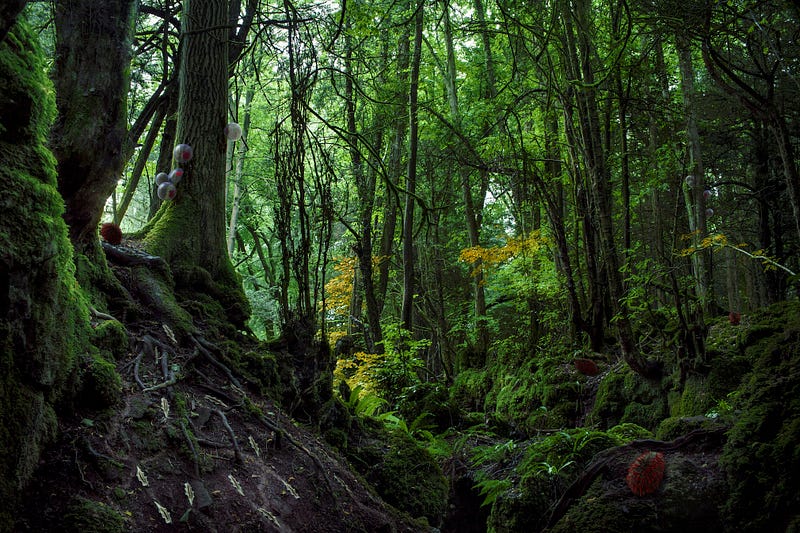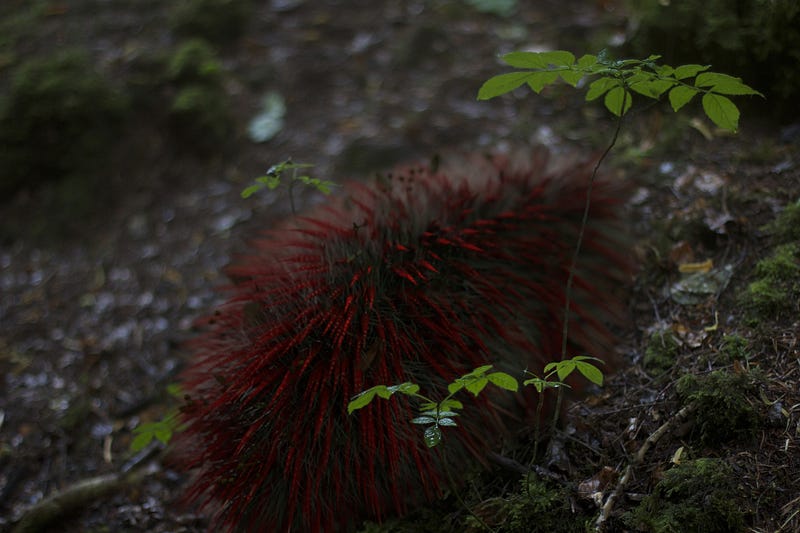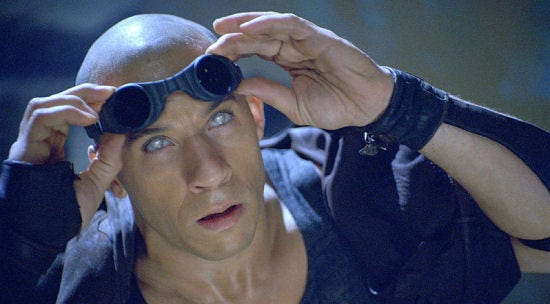Modifying Nature (Humans Included) To Save It — Futures Exchange — Medium

Modifying Nature (Humans Included) To Save It
Tiny people with cat eyes, and other preposterous ideas to save the planet
Imaginative minds are exploring some strange and audacious solutions to our worst environmental problems. They are not, however, for the faint of heart, particularly if you have a strong attachment to the human body as it currently exists.
Biologists have already been toying with the idea of engineering endangered species to make them more resilient, or even resurrecting certain extinct species. But there’s a set of artists and scholars taking the concept of green bioengineering much further, imagining new species of synthetic, beneficial creatures and even biologically modified humans that leave a lighter footprint on the planet.
This idea of manipulating biology to tackle environmental problems can trigger an odd combination of exhilaration and horror. But it also forces us to face just how difficult these problems are. And while they are hypothetical and some admittedly preposterous, the ideas are rooted in real science, and get us thinking about the level to which we’re willing to tinker with nature, and ourselves, for the health of the planet.
For artist Alexandra Daisy Ginsberg, design can play an important role in this discussion, as it helps us grapple with what the future of biotechnology might look and feel like beyond the scale of a petri dish, and therefore explore what we want or don’t want it to become.
Her latest project is curating the art exhibit Grow Your Own…Life After Nature, now showing at Science Gallery at Trinity College Dublin, which asked artists, designers and scientists to provoke discussion around the future of synthetic biology. One of her own installations, Designing for the Sixth Extinction, imagines a fictional fleet of manufactured organisms we might set loose on nature to assist in restoring biodiversity (image above).
This idea of manipulating biology to tackle environmental problems can trigger an odd combination of exhilaration and horror.
For example, manmade slug-like creatures might crawl over acidic soil and neutralize it with a trail of alkali emissions. Or inflated, living pumps could crawl up oak trees and inject them with serum when they detect the pathogens that cause sudden oak death. Of course, the creatures would have Jurassic Park-style limits on lifespan and procreation.

Ginsberg came up with the idea while attending two recent conferences that brought together the conservation community and the synthetic biology community to, in part, discuss whether the technology could be approached not antagonistically, but as an opportunity.
“We need to have this discussion—where do we tolerate, how far will we tolerate intervention into nature. The planet is covered in GM crops, so how is this different? Those are the kinds of arguments I actually want this project to elicit,” she said in an interview. “Once we get past the initial distaste, why do we have these reactions? For me, making a project like this is really about trying to visualize these points so you can start to discuss them more clearly.”
She is quick to point out that she’s not proposing or advocating these ideas as actual solutions, but trying to further thoughtful discussion about synthetic biology as it begins to take shape.
“Because I think it’s scary as well, but I don’t know why I think that,” she said. “That for me, is what sort of motivates me—what are these sort of illogical reactions we have and what is the basis for them?”
The idea of lab-made allies aiding biodiversity is one thing, but to really cut to the heart of environmental devastation, the endgame in biohack talk is engineering humans.

Dutch artist Arne Hendriks’ modest proposal is to shrink us roughly to the size of chickens. Shrink a person to twenty inches tall, drastically reducing our ecological footprint, and say goodbye to world hunger and global warming. Tiny humans mean less food, less clothing, less energy for transportation. Hendriks presented his utterly absurd idea, which he’s been working on for months in what at least appears to be utter seriousness, at the Dutch Design Awards last month, and has been gaining attention since. He imagines a world in which a family could feast on a guinea pig, and only 5% of our cities are necessary, leaving the rest of the world open for agriculture or wilderness.
The Awards selection committee, in its statement evaluating the entry, praised the gall of the idea:
The Incredible Shrinking Man shows us what thinking differently could really mean. Initially, the project seems to be a metaphor. It is performed with so much zest that you can only take the idea seriously.
This seems to be true, based on the earnest debate that surrounds Hendriks’ project. In fact, the idea has already been mooted by S. Matthew Liao, a professor of philosophy and bioethics at New York University.
Last year Liao, along with Anders Sandberg and Rebecca Roache of Oxford, suggested shrinking humans in the journal Ethics, Policy & Environment. The paper, which drew some groans and accusations of trolling, suggested the Lilliputian solution as one of a few radical ways we might engineer humans to mitigate climate change.
The most sci-fi of the proposals involves engineering cat-like eyes for humans, reducing the need for lighting at night.
Their proposed target is more conservative than Hendriks’ twenty inches—a size that makes those guinea pigs we’re supposed to eat seem a bit scary—instead suggesting we scale down human body mass by around twenty five percent. And while Hendriks dances around the actual shrinking process, Liao’s team suggests some real tactics. For example, as used with in vitro fertilization, you could genetically diagnose embryos prior to implantation to select for smaller offspring. A simple hormone treatment to stop growth in children could do the trick, or you could boost the expression of genes from whichever parent is smaller.
Perhaps the mildest of the team’s solutions involves administering medication that makes people ill after consuming beef. A small price to pay if it would eliminate the massive carbon footprint of livestock farms. And it’s not all that far from reality, considering recent reports on a tick-borne affliction that seems to make the parasite’s host allergic to a sugar found in meat.

The most sci-fi of the proposals involves engineering cat-like eyes for humans, reducing the need for lighting at night. The team makes it clear that they are also not advocating for these specific practices. And they emphasize that these technologies would only be used on a voluntary basis, suggesting economic incentives such as tax breaks to encourage people to sign up, while acknowledging the valid concern that this could further shift the burden of climate change onto the poor. They also concede the general outrageousness of their ideas.
Indeed, many of these suggestions—even as fictional concepts—are no doubt appalling to many. Last year, 111 international organizations signed on to The Principles for the Oversight of Synthetic Biology, which called for a moratorium on release and commercial use of synthetic biology until a worldwide framework of mandatory, precautionary regulations could be put into place. They cite, for one, the serious concern about synthetic organisms reproducing, evolving and disrupting ecosystems.
People are right to have the concerns they do, Ginsberg said, but she hopes the future debate will be more nuanced than it often tends to be.
“Everyone gets very emotional about genetic modification. I like to think we need a much more transparent, critical look at what the issues are, and I think it’s a very big task,” she said. “I don’t think it’s as simple as just saying you’re for or against it. And so a moratorium is such a big thing to call for that you automatically polarize the debate.”
The thinkers behind these scenarios also point out that many of the methods are philosophically similar to practices in the status quo, such as vaccinations, fluoridation of water supplies, animal breeding, and IVF. It’s simply a matter of how hard to pull the lever. And given what we stand to lose in the face of climate change, it’s important to accelerate the conversation about the tools in play.
“History is replete with examples of issues or ideas which, whilst widely supported or even invaluable now, were ridiculed and dismissed when they were first proposed.”
As Liao and company put it in their paper:
Discovering the extent to which human engineering — or any of the other solutions currently being considered — is worth pursuing is largely an empirical challenge, and one that we are far more likely to meet in a timely manner if we maintain open minds about which solutions will be best…History is replete with examples of issues or ideas which, whilst widely supported or even invaluable now, were ridiculed and dismissed when they were first proposed.
In other words, the clock is ticking. It’s time to start asking just how far we’re willing to go to save the planet.
